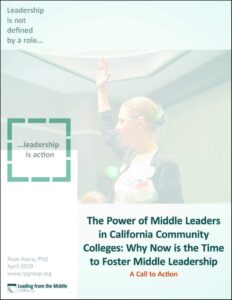By Andrea Venezia, Executive Director, CSU Student Success Network; Rose Asera, Facilitator, CSU Student Success Network; and Bob Gabriner, Consultant, CSU Student Success Network

A new report by the Research and Planning Group (RP Group) of the California Community Colleges, The Power of Middle Leaders in California Community Colleges: Why Now is the Time to Foster Middle Leadership, struck a chord for several reasons. Not only was the RP Group one of the inspirations for creating the CSU Student Success Network, the CSU Network’s Middle Leadership Academy is modeled after Leading from the Middle in the community colleges, and many community college colleagues generously helped get the CSU Network off the ground.
The Power of Middle Leadership describes a system trying to undergo large-scale changes to support new rates and levels of student completion. For example, community colleges are designing and developing Guided Pathways, a framework that is intended to provide a more coherent and supported educational experience for students. (Full disclosure: The CSU Student Success Network is housed at EdInsights, which is the evaluator for the Guided Pathways program).
The report states that in order to reach the system’s goals for increased completion rates, with attention to addressing equity gaps, “Middle leaders are emerging as a powerful resource in California’s community colleges, driving change and advancing student success.” The report paints a picture of a system that has—and has acknowledged—large inequities in student access to resources and in student outcomes.
The same is true in the CSU system. It, too, has large opportunity and outcomes gaps. And our respective organizations share a moral imperative to keep equity-based concerns at the forefront. Our systems are working hard to hire faculty who are representative of our students. And our systems have large goals that are making us rethink and change the structures we use to sort and provide opportunities to students, such as the elimination of remedial (aka developmental) math.
In large systems like these, it’s easy for individual educators to feel ineffectual or disenfranchised, especially if they have experienced years of trying different things, only to be rebuffed by bureaucratic inertia. What’s intriguing to us through our respective endeavors is to figure out how to stay deeply engaged as middle leaders, including how we support capacity building within our systems to address students’ needs.
Our respective organizations share a moral imperative to keep equity-based concerns at the forefront.
The Power of Middle Leaders describes different strategies, currently underway in the community colleges, for developing and supporting middle leaders:
Learning by doing: In a professional learning setting, with hands-on pedagogy, educators have the opportunity to practice leadership skills by planning and preparing to apply those skills to real problems and issues at their campus. After testing out their plans back at their own campuses, people come back together to talk about successes and challenges in order to support their continued engagement in the work. This is part of the model of the CSU Network’s Academy.
Building relationships and collaborating: An individual may feel demoralized by prior attempts at change without seeing results, or after facing resistance from colleagues. However, middle leaders do not have to do our work alone, even though much of academic culture can be individualistic. Middle leadership is inherently collaborative because we all face problems bigger than our own classroom or office. Building relationships and collaborating—especially across silos and across campuses—gives leaders mutual support, a range of different skills, and broader frameworks to consider both problems and solutions. The CSU Network tries to encourage this by asking campuses to send cross-functional teams to events, and by providing time and space at our events for people to talk within and across campus teams.
Preparing to lead institutional change: The moral imperative and passion to help students achieve their goals are at the heart of the desire for change; middle leaders are committed to making their institutions more equitable as well as more effective. However, the process of change is complex and does not follow a linear path. As middle leaders understand the complexity of change, and learn how the college and the system function, they gain broader perspectives and learn to think and navigate more strategically to move towards stronger, more equitable student learning, engagement, progression, and completion.
Deepening identity as a leader: Many educators might be reluctant to see themselves as traditional leaders on campus. One reason for this is that the common view of leadership that society holds is of a lone individual steering the ship or at the top of the hierarchy. Traditional leadership is usually not what draws people to academia, given the latter’s deep history of consultative governance. But we all have the power to change key practices and opportunity structures that affect students. Middle leaders are collaborative, are connected to a network of colleagues, and have the opportunity through ongoing professional learning to gain and practice leadership skills. Rather than being a starting point, identity as a leader cultivates increased knowledge, confidence, and experience, all of which grows from acting on our moral imperative.
The CSU Network has adopted and adapted these practices. It offers day-long convenings that focus on topical issues selected by campuses (such as transfer and supporting students after the first year) and a year-long Middle Leadership Academy for campus teams to focus on an equity-focused issue of practice. The day-long convenings focus mostly on building relationships in order to create the cross-campus contacts people need to share ideas, collaborate, and experiment, while the Academy provides deeper professional learning around all four strategies above. In learning from each other across the largest community college and four-year university systems in the world, we have the opportunity to magnify the effects of all of our respective efforts.
___________
For more in-depth descriptions about professional learning processes in the California Community Colleges, see: Becoming Intentional and Strategic: Developing Middle Leaders in California Community Colleges
